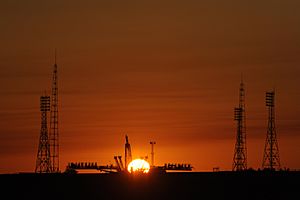Spaceport facts for kids

A spaceport is a special place where spacecraft can take off into space or land back on Earth. Think of it like an airport, but for rockets and spaceships instead of airplanes! Spaceports usually have launch pads, which are the platforms where rockets stand before they blast off. They also have many buildings where scientists and engineers get everything ready for space missions.
Right now, there are only a few spaceports around the world. Most of them are owned by governments, like NASA in the United States or Roscosmos in Russia. These spaceports are mainly used to launch important scientific missions, like sending probes to other planets, or to put satellites into orbit around Earth. Satellites help us with things like GPS, weather forecasts, and TV signals.
In science fiction stories, spaceports are often shown as much busier places, almost like modern airports. In these future stories, many different spacecraft might arrive and depart every day. They often carry passengers, just like an airline carries people on flights today. It's a fun idea to imagine space travel becoming as common as air travel!
Contents
What is a Spaceport?
A spaceport is a facility designed to support the launch, landing, and return of spacecraft. It's more than just a launch pad; it includes all the equipment and buildings needed for space missions. This can involve places to assemble rockets, control centers to monitor launches, and even runways for space planes that land like regular aircraft.
Key Parts of a Spaceport
A typical spaceport has several important parts:
- Launch Pads: These are the platforms where rockets are prepared and launched. They are built to withstand the powerful blast of a rocket engine.
- Vehicle Assembly Buildings: These are huge buildings where different parts of a rocket or spacecraft are put together before a mission.
- Control Centers: From here, teams of experts monitor every step of a launch, from countdown to orbit. They make sure everything goes smoothly and safely.
- Tracking Stations: These stations help follow the spacecraft as it travels through space.
- Fuel Storage: Special facilities are needed to store the large amounts of fuel that rockets use.
Real-Life Spaceports Today
Today's active spaceports are mostly government-run and focus on scientific and commercial launches. One of the most famous is the Baikonur Cosmodrome in Kazakhstan, which Russia uses. It's where the first human in space, Yuri Gagarin, launched from. Another well-known spaceport is the Kennedy Space Center in Florida, USA, operated by NASA. Private companies are also building and using their own spaceports, showing a growing interest in commercial space travel.
Why Are Spaceports Important?
Spaceports are vital for exploring space and using it for our benefit. They allow us to:
- Launch satellites for communication, navigation, and Earth observation.
- Send space probes to study other planets and the universe.
- Launch missions to the International Space Station (ISS), where astronauts live and conduct research.
- Develop new technologies for future space travel and exploration.
Future of Spaceports
As space travel becomes more common, spaceports might change a lot. We might see more private companies building their own launch sites. There could even be spaceports designed for space tourism, allowing everyday people to experience space travel. Some people even imagine spaceports on the Moon or Mars one day, helping us explore even further!
Images for kids
See also
 In Spanish: Base espacial para niños
In Spanish: Base espacial para niños



